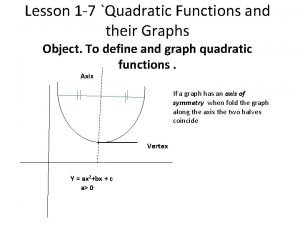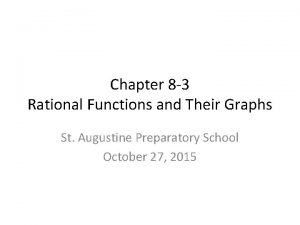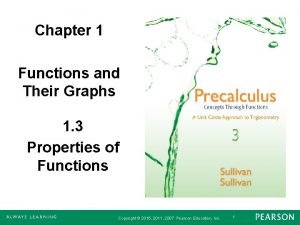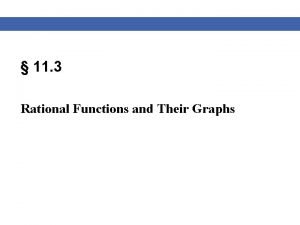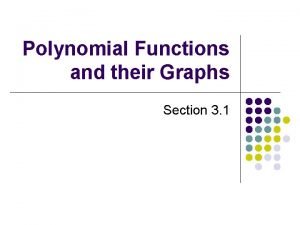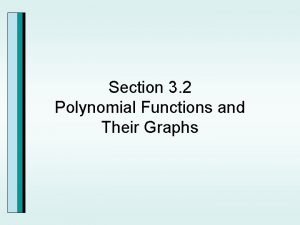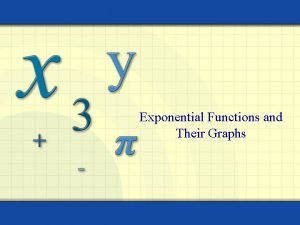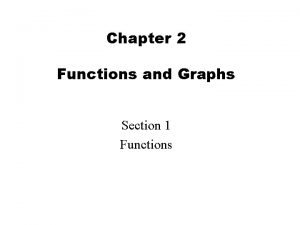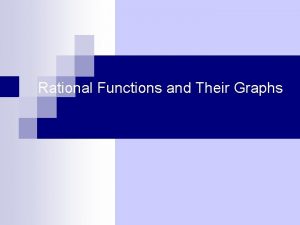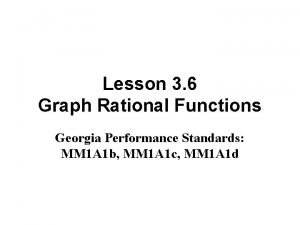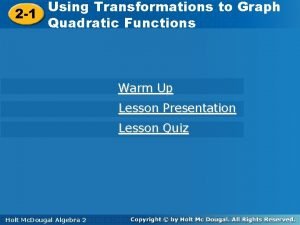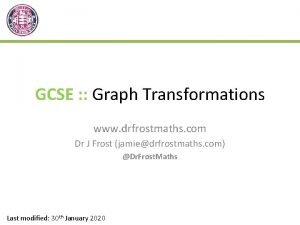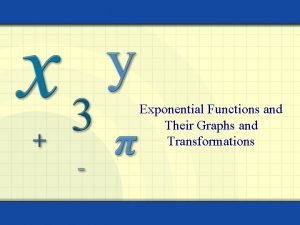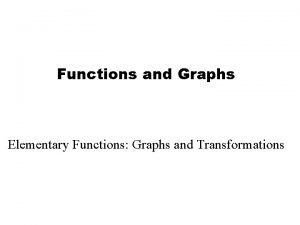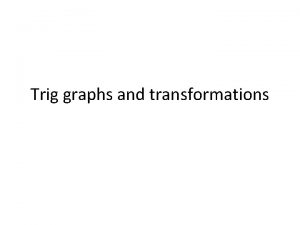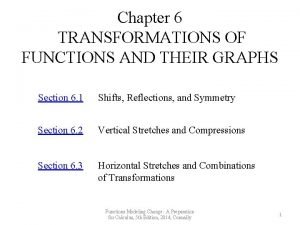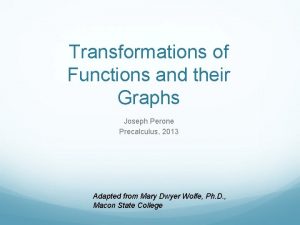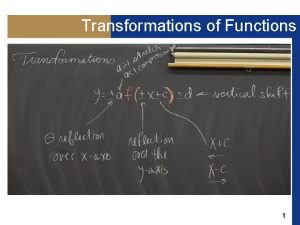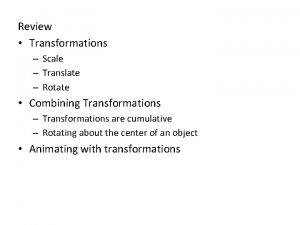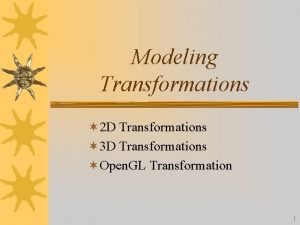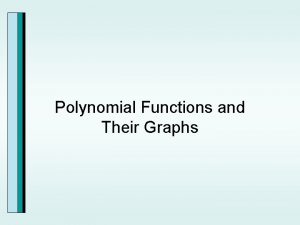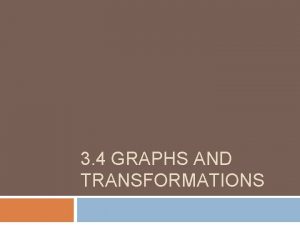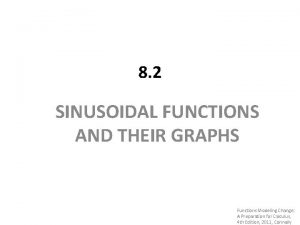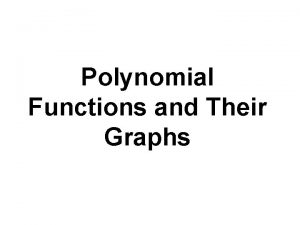RECAP Functions and their Graphs Transformations of Functions





















- Slides: 21

RECAP Functions and their Graphs Transformations of Functions For example: y = a |bx – c| + d. 1

Objectives: • • Recognize graphs of common functions. Use vertical shifts to graph functions. Use horizontal shifts to graph functions. Use reflections to graph functions. Use vertical stretching and shrinking to graph functions. Use horizontal stretching and shrinking to graph functions. Graph functions involving a sequence of transformations. Copyright © 2014, 2010, 2007 Pearson Education, Inc. 2

Graphs of Common Functions Seven functions that are frequently encountered in algebra are: and It is essential to know the characteristics of the graphs of these functions. Copyright © 2014, 2010, 2007 Pearson Education, Inc. 3

Graphs of Common Functions (continued) is known as the constant function. The domain of this function is: The range of this function is: c The function is constant on This function is even. Copyright © 2014, 2010, 2007 Pearson Education, Inc. 4

Graphs of Common Functions (continued) is known as the identity function. The domain of this function is: The range of this function is: The function is increasing on This function is odd. Copyright © 2014, 2010, 2007 Pearson Education, Inc. 5

Graphs of Common Functions (continued) is the absolute value function. The domain of this function is: The range of this function is: The function is decreasing on and increasing on This function is even. Copyright © 2014, 2010, 2007 Pearson Education, Inc. 6

Graphs of Common Functions (continued) is the standard quadratic function. The domain of this function is: The range of this function is: The function is decreasing on and increasing on This function is even. Copyright © 2014, 2010, 2007 Pearson Education, Inc. 7

Graphs of Common Functions is the square root function. The domain of this function is: The range of this function is: The function is increasing on This function is neither even nor odd. Copyright © 2014, 2010, 2007 Pearson Education, Inc. 8

Graphs of Common Functions (continued) is the standard cubic function. The domain of this function is: The range of this function is: The function is increasing on This function is odd. Copyright © 2014, 2010, 2007 Pearson Education, Inc. 9

Graphs of Common Functions (continued) is the cube root function. The domain of this function is: The range of this function is: The function is increasing on This function is odd. Copyright © 2014, 2010, 2007 Pearson Education, Inc. 10

Vertical Shifts Copyright © 2014, 2010, 2007 Pearson Education, Inc. 11

Example: Vertical Shift Use the graph of to obtain the graph of The graph will shift vertically up by 3 units. Copyright © 2014, 2010, 2007 Pearson Education, Inc. 12

Horizontal Shifts Copyright © 2014, 2010, 2007 Pearson Education, Inc. 13

Example: Horizontal Shift Use the graph of to obtain the graph of The graph will shift to the right 4 units. Copyright © 2014, 2010, 2007 Pearson Education, Inc. 14

Reflections of Graphs Reflection about the x-Axis The graph of y = – f(x) is the graph of y = f(x) reflected about the x-axis. Reflection about the y-Axis The graph of y = f(–x) is the graph of y = f(x) reflected about the y-axis. Copyright © 2014, 2010, 2007 Pearson Education, Inc. 15

Example: Reflection about the y-Axis Use the graph of to obtain the graph of The graph will reflect across the x-axis. Copyright © 2014, 2010, 2007 Pearson Education, Inc. 16

Vertically Stretching and Shrinking Graphs Copyright © 2014, 2010, 2007 Pearson Education, Inc. 17

Example: Vertically Shrinking a Graph Use the graph of to obtain the graph of Copyright © 2014, 2010, 2007 Pearson Education, Inc. 18

Horizontally Stretching and Shrinking Graphs Copyright © 2014, 2010, 2007 Pearson Education, Inc. 19

Example: Graphing Using a Sequence of Transformations Use the graph of to obtain the graph of We will graph these transformations in order (BCAD): • right 1 • then stretch vertically • then up 3 Copyright © 2014, 2010, 2007 Pearson Education, Inc. 20

Example: Graphing Using a Sequence of Transformations Use the graph of to obtain the graph of Copyright © 2014, 2010, 2007 Pearson Education, Inc. 21
 5-3 practice polynomial functions
5-3 practice polynomial functions Horizontal asymptotes rules
Horizontal asymptotes rules Quadratic functions and their graphs
Quadratic functions and their graphs Removable and nonremovable discontinuity
Removable and nonremovable discontinuity Chapter 1 functions and their graphs
Chapter 1 functions and their graphs Sketch the graph of the following rational function
Sketch the graph of the following rational function Common functions and their graphs
Common functions and their graphs Number of terms example
Number of terms example Polynomial functions and their graphs
Polynomial functions and their graphs Analyzing graphs of polynomial functions calculator
Analyzing graphs of polynomial functions calculator Exponential functions and their graphs
Exponential functions and their graphs Chapter 2 functions and their graphs answers
Chapter 2 functions and their graphs answers How to find vertical asymptotes of a function
How to find vertical asymptotes of a function Lesson 3: rational functions and their graphs
Lesson 3: rational functions and their graphs Investigating graphs of functions for their properties
Investigating graphs of functions for their properties Investigating graphs of polynomial functions
Investigating graphs of polynomial functions Zczc state graph
Zczc state graph Graphs that enlighten and graphs that deceive
Graphs that enlighten and graphs that deceive Graph using transformations
Graph using transformations Dr frost graph transformations
Dr frost graph transformations Transformations of graphs gcse
Transformations of graphs gcse Vertical translation of an exponential function
Vertical translation of an exponential function


